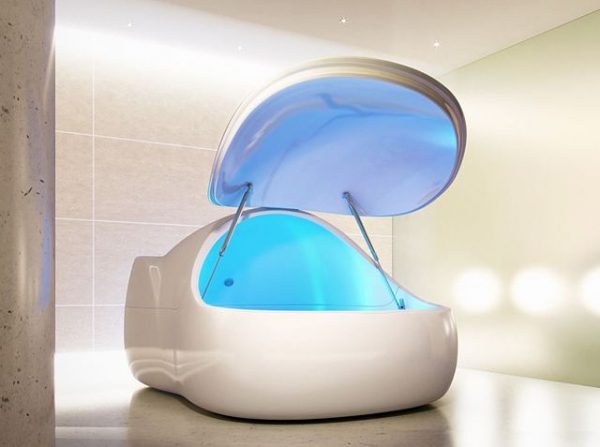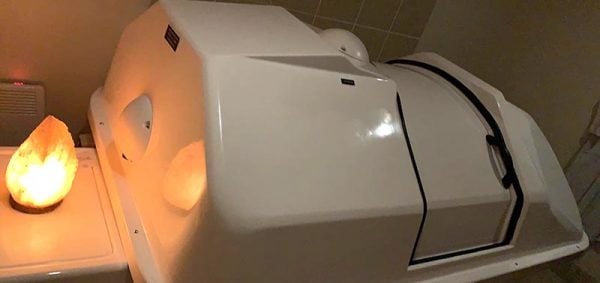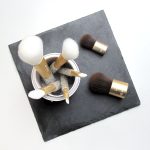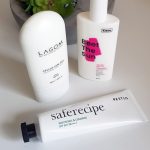One of my work friends is a full on float tank addict. Hugh has been going for floats several times a week and raving about how amazing it is to everyone who’ll listen, so after a few weeks of listening to him go on (and on and on), I finally went for a float myself.

What is a float tank?
A float or flotation tank (also called an isolation or sensory deprivation tank) is a chamber that’s meant to minimise stimulation. It’s designed to block out light, sound and touch so it feels like you’re floating in space.
The bottom of the tank contains around 30 cm (1 foot) of salty water, kept at around skin temperature (35 °C). The salt is magnesium sulfate (Epsom salt), and there’s enough of it to make the water dense enough that you can lie down and float without much effort.
There’s a cover that blocks out light and sound once closed. There’s also a filtration system attached to the tank for cleaning the water.

What are the benefits of floating?
Why would you want to float in the dark in lukewarm water?
There are a bunch of potential benefits to flotation therapy. However, many of these don’t have much high quality evidence to support them, so it’s mostly anecdotal and usually exaggerated by float centre advertising. (One of the big issues with getting quality evidence is that it’s hard to blind people to whether they’re receiving float therapy, so it’s difficult to set up a fair comparison.)
Here are some of the more supported benefits:
- Helps recovery from intense exercise
- Can help with chronic pain
- Reduces stress
- Reduces anxiety
- Enhances sleep quality
- Reduces blood pressure
There’s also a very small chance of the magnesium entering your body during the soak and potentially helping with muscle soreness and if you have a magnesium deficiency, but it’s probably more effective to take a supplement instead.
My floating experience
I went to True Float on Oxford Street in Paddington, Sydney. Since Hugh has a membership, I only paid $50 for a 75 minute session (the regular price is $65).
The tanks are located in separate rooms. Each room contains the tank, as well as a shower in the corner. Before you get into the tank, you shower to get oils and dirt off your body so the water stays clean (the water is also filtered).
Then you put in earplugs to block out noise, but more importantly, keep out the salty water. You sit naked in the tank and scrape water off the roof with a squeegee (so you aren’t rudely disturbed by cold drips on your body in the middle of your session). Finally, you slide the lid closed, turn off the light on the inside (yes there is one! and a help button too), then lie back in the darkness.

What you experience in the tank varies. In general, most people experience deep relaxation. Some people have intense experiences, along the lines of psychedelic drugs, while other people enter a meditative state. Almost everyone has an adjustment period at the start when they try to work out how to lie in the tank.
When I first lay back, I had a mild feeling of panic – what am I meant to do with my body? How far back should I lean? Is the water meant to stay above or below my ears? I knew it definitely shouldn’t be near my eyes, since another friend mentioned that the water stung the crap out of his eyes and it was all he could think about was the pain for the next half hour.
Eventually, with a lot of adjusting, I found a reasonably comfortably position (ears below the water)… then my neck started cramping. After a few minutes I discovered that putting my hands behind my head solved the problem, and then the floating began.
For me it was a very relaxing experience. At first I just sort of lay there blankly, focusing on my breath. As the session went on, it felt like a prolonged version of the moment right before you fall asleep – you’re not actually asleep, but your mind is blank and you’ve lost awareness of where you are and what you are. At one point I completely forgot where I was, and that realisation jolted me awake (which sort of killed the relaxation part).
I was a bit disappointed about the lack of hallucinations (I mean, who wouldn’t be?) but it was an intensely relaxing experience that felt like an incredibly restful nap. My muscles were also less sore afterwards (I exercised hard the evening before). My skin was also incredibly soft thanks to the magnesium sulfate from the water. I left the float centre with wobbly legs and feeling pleasantly sleepy.
I think that floating would have been absolutely fantastic during my insomnia earlier this year, when I didn’t feel well-rested for about a month. I also think it would be fantastic if you’re feeling stressed, as a forced timeout for your brain. Since I’m naturally pretty good at relaxing, and I went during a reasonably low-stress time of my life, I think the benefits weren’t as
Tips for floating
Neck/upper back cramps or your head being super heavy: At True Float there’s a buoyant foam pillow for supporting your head provided, but they recommend that you try without the pillow first. I found that putting my hands behind my head worked well.
Open wounds: If you have any open wounds, make sure you have a waterproof bandage on, and cover any small ones with Vaseline. Make sure you don’t skip this step! I had a small paper cut and mild carpet burn on my knee, and both of these stung annoyingly for a good while after I got into the tank.
Long hair: I’d recommend tying up long hair before you go into the tank – the floating strands really annoyed me.
Bleeding hair dye: If your hair is brightly coloured, make sure your water runs clear in the shower before you go into the tank! Some centres will make you pay a cleanup fee if your hair dye ruins their water.
Water going in your ears: Put in your earplugs firmly, or rinse your ears very thoroughly after you float (some places provide vinegar for this). Even though I put my foam earplugs into my ears very firmly, a little water still leaked into my right ear. After it dried the next day, there was a constant annoying crackling noise that only went away after I irrigated it with a few syringefuls of water. Annoyingly, Hugh is deaf so he couldn’t warn me about this issue!
Water in your eyes: Don’t let water into your eyes. It’ll hurt. Lie backwards slowly and don’t turn your head suddenly.
Squeegee the inside of the tank first: Make sure you scrape the condensation off the inside of the tank before you lie back. Cold drips aren’t super relaxing!
Shower before and after: Don’t forget to pack sunscreen and/or makeup if you need them after your float and shower. True Float has a little station with makeup remover, hair dryer and straightener, and they provide shower gel, shampoo and conditioner in the show
Be careful not to slip! The floors can be very slippery, especially with the salt! Take lots of care when stepping in and out of the tank.
Go to the toilet before you start floating: You don’t want to be distracted by a full bladder.
Eat a light meal beforehand: You also don’t want to be distracted by being bloated, or have a dizzy spell.
References
Jonsson K & Kjellgren A, Curing the sick and creating supermen – how relaxation in flotation tanks is advertised on the Internet (open access), Eur J Integr Med 2014, 6, 601–609. DOI: 10.1016/j.eujim.2014.05.005
van Dierendonck D & Te Nijenhuis J, Flotation restricted environmental stimulation therapy (REST) as a stress-management tool: A meta-analysis, Psychol Health 2005, 20, 405–412. DOI: 10.1080/08870440412331337093
Feinstein JS et al., Examining the short-term anxiolytic and antidepressant effect of Floatation-REST (open access), PloS one 2018, 13, e0190292. DOI: 10.1371/journal.pone.0190292
Jonsson K & Kjellgren A, Promising effects of treatment with flotation-REST (restricted environmental stimulation technique) as an intervention for generalized anxiety disorder (GAD): a randomized controlled pilot trial (open access), BMC Complement Altern Med 2016, 16, 108. DOI: 10.1186/s12906-016-1089-x
Kjellgren A & Westman J, Beneficial effects of treatment with sensory isolation in flotation-tank as a preventive health-care intervention – a randomized controlled pilot trial (open access), BMC Complement Altern Med 2014, 14, 417. DOI: 10.1186/1472-6882-14-417.
Ingraham P, Does Epsom Salt Work? https://www.painscience.com/articles/epsom-salts.php (accessed 6 Oct 2019).






Sounds like a fun experience! I don’t know how to float. Will that be an issue?
I think the spa will provide you with a pillow so you keep floating. Plus i guess since it has salt, that would help with you floatin, too.
That sounds kind of fun, although I would be disappointed by the lack of halluzinations as well.
I heard about this in a Youtube video before, but I never thought it could also be beneficial for the skin. The reviewer said he had an almost heavenly experience he thought he wanted to cry. Okay, so that does seem like a nice experience.
I toured a float facility once (didn’t have time for a float) but they provided a spray bottle in case you got salt in your eyes during the float, seems like a good idea.